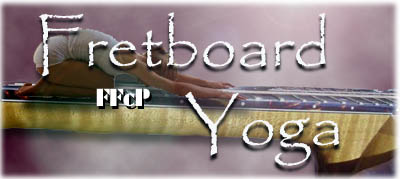Working Chromatic Descending and Ascending Tonal Centers
To review, the first lesson FFcP introduced our movable closed fingering concept. The second "Moving on Up" had you take this up the fretboard. The third Super FFcP gave you a warm up routine you could use to limber up the fingers every day and systematically cover all the positions. The fourth Patterns Overboard spread them even farther over the frets mixing them like a set of flash cards.
If you've worked up the first four lessons in the FFcP series, it's time to develop some dexterity within the juiciest range of the fingerboard, sometimes referred to as the 3rd position. At least in violin pedagogy, placing the 1st finger on what would be equivalent to the 5th fret to start scales, you can unlock some amazing tonal potential. You have the advantages of a tad shorter scale length, but the resonance of a longer string. It's not as rich as an open string, but keeping things closed gives you a more consistent timbre, should you want to limit sections of your soloing to an octave range.
We want to introduce you to an exercise that develops this, but also gives you a chance to work 4 consecutive chromatic keys. Why is this important?
In Jazz, you'll occasionally find descending or ascending chromatic tonal centers, or at least this is a way to spice up a static set of measures. Say you're jamming in F but you want to "play outside" by improvising a measure in E or Gb. This is easy to do by moving your fingers up or down a fret, OR you can start the next FFcP pattern on the next fret. In real life you'll probably alternate between both, but the following exercise will help you develop facility moving in the latter.
In more complicated songs, you'll find a descending 'ii V7' set, like a common alteration found in the Vernon Duke "I Can't Get Started." Often, you'll hear what was originally written in the 3rd & 4th measures:
TWO BEATS FOR EACH CHORD
E6 Am7b5 D7 G7
Instead played:
ONE BEAT FOR EACH CHORD
Bm7 E7 Bbm7 Eb7 Am7 D7 Abm7 Db7
If you want to improvise the alternate changes, analysis reveals two beats of the key of A, two beats Ab, two beats G, and two beats Gb. You could move your fingers down a fret for each key, or using our FFcP just use 4 different FFcP positions you've already drilled into your fingers.
This will make more sense after you've become familiar with the exercise, Chromatic Mastering. A quick Roadmap to this:
Starting on G string
Key of Bb 1st FFcP
Key of B 2nd FFcP
Key of C 3rd FFcp
Key of Db 4th FFcP
Starting on D string
Key of F 1st FFcP
Key of F# 2nd FFcP
Key of G 3rd FFcp
Key of Ab 4th FFcP
Work Scale, Thirds, 'I vi7 ii7 V7', Fourths.
Once this becomes finger friendly, you can start to tackle other standards that change key centers chromatically, like the last two measures of the verse in Satin Doll, third measure in 'Round Midnight, the 6th measure and final vamp in The Girl From Impanema. "
Note the exercise is in the Major Scale or Ionian Mode. You can also take the same approach by delete the 'I vi7 ii7 V7' measures and using other modes, but for now, just get comfortable with it as written.
Download Exercise: Chromatic Mastering
Pay attention to the practice tips:
- Accept no compromise; allow only healthy, ringing notes be unwilling to move to the next measures until this is accomplished.
- Work on the the relationship between neighboring consecutive fingering pairs--1st & 2nd, 2nd & 3rd, 3rd & 4th. Get comfortable with the transition from one to the next in the pair.
- This is not a race. Speed is a by-product of good tone and not the the other way around...
- The exercise is as much about tone as it is fretboard familiarity. Keep the fingers low and stealth, at-the-ready for smooth and stable note connectivity.
- Enjoy the rich tone potential within this range of your instrument's fingerboard. Soloing and melodic mojo is maximum in this register.

Join the FFcP 'Fretboard Yoga' Facebook Group

Disclaimer: In the 'Information Age' of the 21st Century,
any fool with a computer, a modem, and an idea can
become a self-professed 'expert." This site does not
come equipped with 'discernment.'
|



